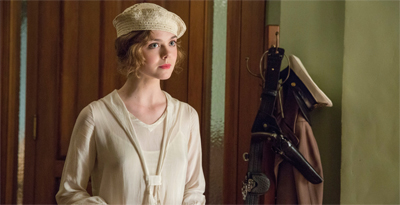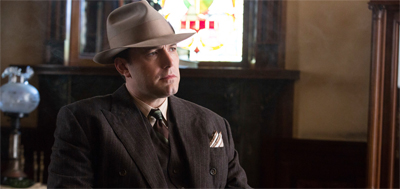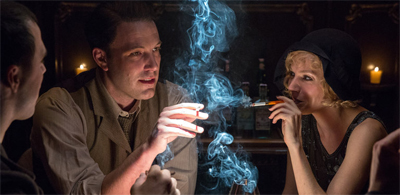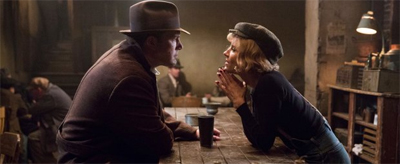Live by Night is a film with big ideas. Writer, director, producer and star Ben Affleck is very clearly attempting to use the classic gangster film as a commentary upon the American Dream. This is hardly a novel idea, but it still resonates as powerfully as it did during the pulp era of the thirties and forties. Working from a novel by Dennis Lehane, Affleck crafts a story about violence and power that is clearly intended to resonate with modern audiences looking to understand fundamental aspects of the American identity.
And there are moments when Live by Night really works. Affleck is a solid writer and a performer who can skilfully channel that old-school Hollywood charm, but he has proven himself a very impressive director. Live by Night is occasionally a beautiful film, as the camera pans across the wilderness of the Florida everglades or spins around a room during a tense dialogue scene or even just captures the lead character on the shore with the reflection of the sky framed so perfectly that it seems like he is standing upon the edge of heaven itself.

Speaking easy.
However, these moments are assembled in a haphazard fashion around a disjointed plot. Live by Night plays like a stream of consciousness attempting to delve into the symbolic heart of the United States, tossing out crazy ideas like a turf war between Prohibition gangsters and the Ku Klux Klan or arbitrarily drawing long-absent characters back into the narrative with little foreshadowing. Live by Night seems to navigate by night, prone to storytelling detours and narrative cul de sacs that undercut (rather than enrich) its thematic intent.
Live by Night is built like an epic, but its script lacks the discipline and structure to justify an impressive running time. Affleck is a strong enough director that the film never collapses, even as it stumbles. There is a sense that the writer and director is having a great deal of fun playing with a very archetypal set of iconography and themes, and that fun is occasionally contagious. However, Live by Night never truly comes alive in the way that it promises.

Sea changes.
The obvious point of comparison for Ben Affleck is Clint Eastwood. Both are actors who became directors, and who arguably became more distinguished in that latter role. Both hark back to an older model of filmmaking, both in their pet themes and their standard operating procedure. Affleck and Eastwood have both negotiated their own understanding with Warner Brothers, allowing them a freedom to develop projects and ideas that interest them in exchange for the occasional concession to the demands of the studio.
Like Eastwood, Affleck seems to belong to a more conservative school of film direction with an eye squarely on the past. Eastwood’s preoccupations include themes like ageing and responsibility, particularly the recurring notion of failed parents and fallen authority figures. Affleck’s interests seem somewhat broader, a genuine investment in the art of old-school American mythmaking. There were shades of it in the hardboiled aesthetic of Gone Baby Gone and the outlaw myth of The Town, but it was particularly clear in Argo.

Here comes the (cham)pagne…
In some respects, Live by Night could be seen as a fusion of these earlier films, a strange cocktail of Affleck’s influences and interests. Like Gone Baby Gone, Live by Night is based upon a Dennis Lehane novel, and so its DNA is quite familiar to Affleck. Like The Town, Live by Night plays upon the familiar archetype of the bad man who might just want to make good in a world that won’t let him. Like Argo, Live by Night feels like an affectionate homage to classic Hollywood cinema, albeit in a much less direct manner.
In fact, Live by Night weds the outlaw cynicism of The Town to the old school Hollywood aesthetic of Argo. The plot keeps its distance from Hollywood, with one young starlet taking a trip to Hollywood but never escaping Los Angeles, while there are several allusions to Joe Coughlin’s unseen brother who works as a stuntman in the industry. However, in terms of style and tone, Live by Night is constructed around the popular and enduring image of gangster life as filtered through frames of celluloid.

Yes, Live by Night is so old-timey that Joe actually wears a piece of paper marked “PRESS” in his cap.
Affleck certainly isn’t modest in his aspirations. Live by Night repeatedly and consciously harkens towards The Godfather, with its focus on the immigrant experience and its fascination with examining the American Dream through the melancholy trappings of a reluctant gangster film. Like Michael Carleone, Joe Coughlin is a former soldier who never wanted to be a gangster. Instead, he becomes one by fate. Like the Carleones, he is a “good” gangster, with other characters repeatedly stressing that he doesn’t deal drugs.
Even the smaller touches demonstrate an abiding affection for The Godfather. During one scene between gangsters, a minor character absent-mindedly chews an orange, Francis Ford Coppola’s cinematic shorthand for imminent death. Coughlin hopes to go legitimate through his links with Cuban ex-patriots in Florida, only a few years ahead of Michael Carleone’s later ill-fated attempts on the island itself in The Godfather, Part II. As such, Live by Night occasionally feels like a film as much about gangster films as it is about gangsters.

All fired up.
However, Live by Night is also underscored by an earnestness. The film grasps eagerly at relevance. The obvious use of organised crime to explore the idea of the American experience is a familiar trope, but one that feels rather timeless. However, Affleck insists that Live by Night be anchored in the moment of its production. The script is littered with awkward nods towards contemporary politics, as if worried that the audience might find Joe Coughlin’s tragedy dated without the proper social context.
Although Live by Night only ever portrays the aftermath of a bank robbery, the characters are all very eagerly invested in the current state of the banks. The narrative unfolds across the twenties and thirties, against the backdrop of Prohibition and leading into the Great Depression. At that point, characters repeatedly and emphatically stress that the common people have lost faith in the banks, a conscious nod to current attitudes in the wake of the Great Recession.

To Elle and back.
At the same time, these references feel somewhat hollow. After all, as Joe Coughlin acknowledges in his first reference to the failure of the banks, rum-running is a Depression-proof business. In fact, Joe even sees profits increase during the Great Depression. The film never actually shows any of the suffering and loss to which it alludes through narration and dialogue. As such, these repeated references feel like a cynical nod to twenty-first century audiences who might have difficulty engaging with a story set almost a century earlier.
Still, there are moments at which this relevance does shine through. Most notably, the recurring emphasis on the cultural divide that exists between various ethnic groups within Florida. Arriving in the state, Joe finds himself walked through the complex social hierarchy that exists, confronting the reality that immigrants are still largely outsiders in the country. Joe frequently finds himself navigating a complex social web, as the son of an Irish immigrant dealing with the Protestant settlers, the Italian community and the Cuban ex-pats.

Hat’s entertainment.
Coughlin’s efforts to establish himself using a complex and delicate alliance of minority interests, juxtaposed against the nationalist and tribalist barriers that block him, provide a powerful resonance at this moment in time. Confronting a more established broker with little patience for the local community, Coughlin warns that his attack will not come from the outside. “We’re comin’ up from beneath you,” he warns his opponent, in an endearingly overt piece of narrative symbolism.
Indeed, Live by Night‘s earnestness is strangely appealing. There is little room for irony in the film’s worldview. Indeed, characters will frequently explain in the most straight-forward manner possible what is about to happen. Early in the film, Joe Coughlin receives a stern warning from his father. “What you put out in this world will always come back to you, but it never comes back how you would predict.” The rest of the film dutiful feels like an extended set-up for that cruel punchline.

The big smoke.
This is the central problem with Live by Night. It is a very simple film in terms of theme and plot, but the screenplay wanders wildly and unevenly. Live by Night ducks down into surreal tangents, allowing them to unfold, before desperately tidying them away with an awkward voice-over. Frequently, Live by Night will set up a big conflict that escalates the stakes, only to rapidly let the air out. This is most notable in terms of a gang war in the middle of the film. A solid half-hour is spent building to it, only for it to resolve via montage and voice-over.
In theory, it is easy to see how this might work. After all, that heavy-handed prophecy makes it clear that Live by Night does not intend to be a story of linear set-up and pay-off. However, the issue is that it never shifts gears in a fluid and organic manner. At one point in the film, Joe botches a bank robbery by accidentally kicking his getaway car into reverse. It frequently feels like Affleck has done something similar with the script, never gracefully transitioning from one crisis or challenge to the next.

Taking the Sienna-ic route.
There is something to be said for a more relaxed and disjointed school of cinematic storytelling. After all, life itself cannot be reduced to a simple string of cause-and-effect. There are plenty of films that effectively capture that sense of arbitrary logic, the coincidences and happenstances that make up so much of human existence. The big issue with Live by Night is that it all feels too carefully and too meticulously constructed to capture that lackadaisical “slice of life” tone. Affleck is too manner a director to let the story flow.
This is not a bad thing. Affleck’s technical precision and honed craft mean that Live by Night is frequently impressive. Early in the film, Affleck constructs a stunning adrenaline-driven car chase featuring cars that would be lucky to run over thirty miles an hour. Later on, the camera spins through a cramped room for a dizzying long take as Joe attempts to forge an alliance in a strange land. As a director, Affleck always knows exactly what he is doing, and his work always feels tight.

Gang star.
This attention to detail is impressive, but it also works against the script. The tangents and diversion of Live by Night need to feel organic and stream of consciousness, a reflection of the strange directions that a life might take. However, Affleck feels so strongly in control of the film, that every decision appears conscious and every inefficiency is rendered criminal. Live by Night is populated by story threads that should feel like detours but instead play as wrong turns.
Still, there is a pulpy charm and an endearing earnestness to Live by Night that keeps the film afloat even as it drifts off-course. The result is a film more intriguing than successful, one fun to think about but mildly irritating to watch.
Filed under: Non-Review Reviews | Tagged: ben affleck, film, live by night, Movie, non-review review, review |




















That’s such a great review. You identify the great aspects of this film but also describe the flaws.
Thanks Greer! Glad you enjoyed it!